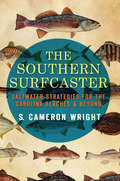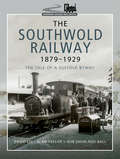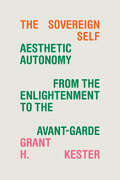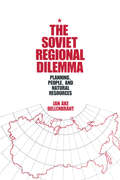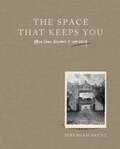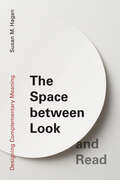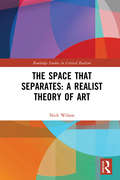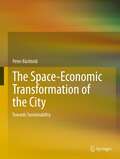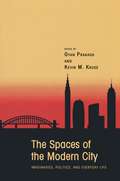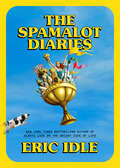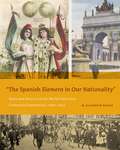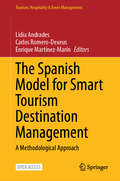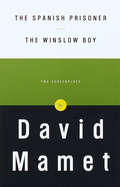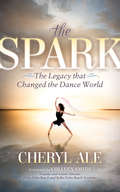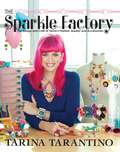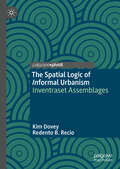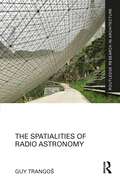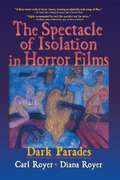- Table View
- List View
The Southern Rustic Cabin
by Emily J. FollowillExplore the beauty, tradition, and stylish renovation of rustic mountain homes across the Southern Appalachians in this gorgeously photographed book. The cool, wooded mountains of the South are dotted with log cabins, each with its own rich history and aesthetic charm. In The Southern Rustic Cabin, photographer Emily Followill captures the rugged beauty and unique personality of thirteen mountain homes located across Tennessee, Georgia, North Carolina, Alabama, and Virginia. The homeowners have lovingly preserved the age-old qualities of their cabins while renovating, revitalizing, and redecorating them to support modern living and reflect their personal style. Alongside her stunning photography of interiors and exteriors, Followill tells the story of how each cabin and owner came together; as the owners changed their cabins, the cabins invariably changed the owners as well.
The Southern Sky Guide
by Wil Tirion David EllyardThis unique and accessible book provides a handy reference to the skies visible from the countries of the southern hemisphere. Amateur astronomers or casual observers of the night sky will have easy access to the star charts of world famous astronomical cartographer Wil Tirion, prepared especially for this volume. Television astronomer David Ellyard has contributed a detailed explanatory text to accompany the charts, together with a general introduction to the study of the night sky. Charts of the whole sky - 24 in all - show what is visible early and late in each month. These are followed by details of each section of the sky, with particular attention to the constellations seen in the southern skies. For this new edition, the text has been thoroughly revised and new charts created to illustrate the legends behind the main constellations. Planet positions are provided up to 2010.
The Southern Surfcaster: Saltwater Strategies For The Carolina Beaches And Beyond
by S. Cameron WrightThe Southern Surfcaster will increase your knowledge of fishing and help you develop into a more confident salt-water fisherman. Explore creative techniques and the latest strategies that have transformed the sport over the last decade. Many of the old-school methods of fishing are updated for modern practicality. The Southern Surfcaster will change the way you think and what you thought you knew about salt water fishing.
The Southwold Railway 1879–1929: The Tale of a Suffolk Byway (Narrow Gauge Railways)
by Alan Taylor David Lee Rob Shorland-BallA journey through the history of this railway that brought passengers to the English seaside for fifty years. Includes maps and photos. The Southwold Railway was a delightful example of one of East Anglia's minor railways: A 3ft gauge railway, single track, just over eight miles long from Halesworth (connections to London) across the heathland and marshes of East Suffolk to the seaside resort and harbor of Southwold. This book collates the research and memories of one of the last surviving passengers with maps and pictures to tell a fascinating tale of immaculate passenger service, management from a distant London office, closure at very short notice, and twenty-first century revival.
The Sovereign Self: Aesthetic Autonomy from the Enlightenment to the Avant-Garde
by Grant H. KesterIn The Sovereign Self, Grant H. Kester examines the evolving discourse of aesthetic autonomy from its origins in the Enlightenment through avant-garde projects and movements in the nineteenth and twentieth centuries. Kester traces the idea of aesthetic autonomy—the sense that art should be autonomous from social forces while retaining the ability to reflect back critically on society—through Kant, Schiller, Hegel, Marx, and Adorno. Kester critiques the use of aesthetic autonomy as the basis for understanding the nature of art and the shifting relationship between art and revolutionary praxis. He shows that dominant discourses of aesthetic autonomy reproduce the very forms of bourgeois liberalism that autonomy discourse itself claims to challenge. Analyzing avant-garde art and political movements in Russia, India, Latin America, and elsewhere, Kester retheorizes the aesthetic beyond autonomy. Ultimately, Kester demonstrates that the question of aesthetic autonomy has ramifications that extend beyond art to encompass the nature of political transformation and forms of anticolonial resistance that challenge the Eurocentric concept of “Man,” upon which the aesthetic itself often depends.
The Soviet Regional Dilemma
by Jan Ake DellenbrantIncorporating an oral history approach, this history of radio covers the impact of the arrival of television, the rise of transistor radios, the popularity of rock n' roll, FM stereo stations, underground radio of the sixties, talk radio, public radio, and how technology will affect its future.
The Soviet Theater
by Mr Laurence Senelick Mr Sergei OstrovskyIn this monumental work, Laurence Senelick and Sergei Ostrovsky offer a panoramic history of Soviet theater from the Bolshevik Revolution to the eventual collapse of the USSR. Making use of more than eighty years' worth of archival documentation, the authors celebrate in words and pictures a vital, living art form that remained innovative and exciting, growing, adapting, and flourishing despite harsh, often illogical pressures inflicted upon its creators by a totalitarian government. It is the first comprehensive analysis of the subject ever to be published in the English language.
The Space That Keeps You: When Home Becomes a Love Story
by Jeremiah BrentInterior designer and television host Jeremiah Brent explores the emotional meaning of home in this warm and inviting book that illuminates what make peoples’ spaces so personally significant.For many of us, our houses are more than just where we hold our belongings. They are reflections of who we are and where we’ve been. They represent our aesthetics, our personalities – provide us with purpose and intention, and if we’re lucky, a safe space to live and create. For years, Jeremiah Brent and his family lived in one beautiful home after the next. Yet after a short time, they always felt the pull to move on. Curious to understand why, he embarked on a deeply personal mission to discover what makes a home a space that keeps you.The Space That Keeps You isn’t just a study of beautiful interior design; it’s an emotional design book that explores what gives spaces meaning. Through candid conversations with nine individuals and families varying in backgrounds, lifestyles, and geographic locations, Jeremiah reveals how and why the spaces we inhabit come to feel like they truly belong to us—the memories, emotions, and stories that shape what home signifies.He introduces memorable people like the artist couple James and Alexandra Brown and their children who made an abandoned plot in Merida, Mexico their accidental paradise, and Tracy and Brian Robbins who found refuge during the pandemic in a serene single-story home in Montecito surrounded by fields of lavender. He illuminates a personal side of Oprah Winfrey as she speaks to the importance of nature in her dream of home, and describes the story of Giberto and Bianca Arrivabene, who fought to hold onto their family’s historic Venetian palazzo. Their stories are bookended by Jeremiah’s recollections of his own journey defining home with his husband, fellow interior designer and television personality Nate Berkus, and their two children.Filled with intimate, meaningful details—from the kitchen that now nourishes the grandchildren of the adoring couple who first cooked there fifty years ago to the beams of one apartment’s walls that are etched with hearts to literally represent the love that fills it—and accompanied by 300 inviting and inspiring color photographs— The Space That Keeps You illustrates the essence of what makes a house a home. Just like Jeremiah himself, readers will leave this book with a newfound appreciation for the places that connect and shape us.
The Space between Look and Read: Designing Complementary Meaning
by Susan M. HaganUnleashing the potential that can be found in the space between words and images.Designers have long understood that image, text, and typeface can work together to produce new meanings, creating semiotic registers impossible to achieve with image or text alone. In The Space Between Look and Read, a study of complementary meaning in design, Susan Hagan presents a framework, called Inter-play, which explains how these new meanings emerge. Inter-play is not simply an analytical tool; it is also a method for using complementary meaning to encourage critical thinking in design audiences. Drawing from cognitive psychology, art theory, discourse analysis, design, and rhetoric, Hagan breaks down the synthesis of looking and reading into a complex series of registers, which are revealed through examples of excellent design. Thus, the book is both a theoretical exploration of how designers communicate and a casebook in communication well achieved. From the physiology of vision to the limits of language, from Allan Paivio to Uwe Loesch, The Space Between Look and Read expands our understanding of complementary design and argues that by engaging audiences through multiple cognitive registers, complementary design serves as a cognitive tool, helping audiences reach new conclusions about complex problems.
The Space that Separates: A Critical Realist Aesthetics (Routledge Studies in Critical Realism)
by Nick WilsonThe Space that Separates: A Realist Theory of Art radically challenges our assumptions about what art is, what art does, who is doing it, and why it matters. Rejecting the modernist and market-driven misconception that art is only what artists do, Wilson instead presents a realist case for living artfully. Art is defined as the skilled practice of giving shareable form to our experiences of being-in-relation with the real; that is to say, the causally generative domain of the world that extends beyond our direct observation, comprising relations, structures, mechanisms, possibilities, powers, processes, systems, forces, values, ways of being. In communicating such aesthetic experience we behold life’s betweenness – "the space that separates", so coming to know ourselves as connected. Providing the first dedicated and comprehensive account of art and aesthetics from a critical realist perspective – Aesthetic Critical Realism (ACR), Wilson argues for a profound paradigm shift in how we understand and care for culture in terms of our system(s) of value recognition. Fortunately, we have just the right tool to help us achieve this transformation – and it’s called art. Offering novel explanatory accounts of art, aesthetic experience, value, play, culture, creativity, artistic truth and beauty, this book will appeal to a wide audience of students and scholars of art, aesthetics, human development, philosophy and critical realism, as well as cultural practitioners and policy-makers.
The Space-Economic Transformation of the City
by Peter BächtoldCity planning is the key-stone to tackle the question of climate-change and to involve adequate action. In Part I of this book, the theory of space-economy is presented. Opening up a new conceptual and operational toolbox for policy makers, practitioners and scholars, the theory of space-economy is based on a rigorously structured thinking and acting in the field of sustainable urban planning and architecture. Europe has the greatest experience in sustainable city planning worldwide. In Part II, four of the most remarkable experiences (Vauban in Freiburg i.B., Kronsberg in Hannover, Western Harbour in Malmö, Hammarby Sjöstad in Stockholm) are presented, dissected conceptually and operationally a radically new way. The interest of the approach is not limited to European countries. In Part III is developed a project in Asia, in Ho Chi Minh City, faced with dramatic threats due to climate change and rapidly growing tidal and sea-level rise. Based on the experiences presented in Part II, the approach is integrated in this completely different context, thus becoming fully effective at a much bigger scale.
The Spacemaker's Guide to Big Change: Design and Improvisation in Development Practice (Earthscan Tools for Community Planning)
by Nabeel HamdiThis book gives definition to participatory practice as a necessary form of activism in development planning for cities. It gives guidance on how practice can make space for big and lasting change and for new opportunities to be discovered. It points to ways of building synergy and negotiating our way in the social and political spaces ‘in between’ conventional and often competing ideals – public and private interests, top down and bottom up, formal and informal, the global agendas which outsiders promote and the local needs of insiders, for example. It offers guidance on process, designed to close gaps and converge worlds which we know have become divisive and discriminatory, working from the detail of everyday life in search of beginnings that count, building out and making meaningful locally, the abstractions of the global causes we champion – poverty alleviation, environmental sustainability, resilience. Practice – the collective process by which decisions are negotiated, plans designed and actions taken in response to needs and aspirations, locally and globally – we will see, is not just about being practical, but more. Its purpose is to give structure to our understanding of the order and disorder in our cities today, then to disturb that order when it has become inefficient or inequitable, even change it. It is to add moral value to morally questionable planning practice and so build "a social economy for the satisfaction of human need." Practice in these spaces ‘in-between’ redraws the boundaries of expectation of disciplinary work and offers a new high ground of moral purpose from which to be more creative, more integrated, more relevant, more resourceful – more strategic.
The Spaces of the Hospital: Spatiality and Urban Change in London 1680-1820
by Dana ArnoldThe Spaces of the Hospital examines how hospitals operated as a complex category of social, urban and architectural space in London from 1680 to 1820. This period witnessed the transformation of the city into a modern metropolis. The hospital was very much part of this process and its spaces, both interior and exterior, help us to understand these changes in terms of spatiality and spatial practices. Exploring the hospital through a series of thematic case studies, Dana Arnold presents a theoretically refined reading of how these institutions both functioned as internal discrete locations and interacted with the metropolis. Examples range from the grand royal military hospital, those concerned with the destitute and the insane and the new cultural phenomenon of the voluntary hospital. This engaging book makes an important contribution to our understanding of urban space and of London, uniquely examining how different theoretical paradigms reveal parallel readings of these remarkable hospital buildings.
The Spaces of the Modern City: Imaginaries, Politics, and Everyday Life (Publications in Partnership with the Shelby Cullom Davis Center at Princeton University #2)
by Gyan Prakash & Kevin M. KruseBy United Nations estimates, 60 percent of the world's population will be urban by 2030. With the increasing speed of urbanization, especially in the developing world, scholars are now rethinking standard concepts and histories of modern cities. The Spaces of the Modern City historicizes the contemporary discussion of urbanism, highlighting the local and global breadth of the city landscape. This interdisciplinary collection examines how the city develops in the interactions of space and imagination. The essays focus on issues such as street design in Vienna, the motion picture industry in Los Angeles, architecture in Marseilles and Algiers, and the kaleidoscopic paradox of post-apartheid Johannesburg. They explore the nature of spatial politics, examining the disparate worlds of eighteenth-century Baghdad, nineteenth-century Morelia, Cold War-era West Berlin, and postwar Los Angeles. They also show the meaning of everyday spaces to urban life, illuminating issues such as crime in metropolitan London, youth culture in Dakar, "memory projects" in Tokyo, and Bombay cinema. Informed by a range of theoretical writings, this collection offers a fresh and truly global perspective on the nature of the modern city. The contributors are Sheila Crane, Belinda Davis, Mamadou Diouf, Philip J. Ethington, David Frisby, Christina M. Jiménez, Dina Rizk Khoury, Ranjani Mazumdar, Frank Mort, Martin Murray, Jordan Sand, and Sarah Schrank.
The Spamalot Diaries
by Eric Idle&“A rollicking account of the making of [the] Broadway musical Spamalot [and] an irresistible and unfiltered ode to the art of live theater. Fans will love this tantalizing glimpse behind the curtain.&”—Publishers Weekly (starred review)From comedy legend Eric Idle, the fascinating inside story of bringing Monty Python and the Holy Grail to Broadway as the unlikely theatrical hit Spamalot On March 17, 2005, Spamalot debuted on Broadway to rapturous reviews for its star-studded creative team, including creators Eric Idle and John du Prez, director Mike Nichols, and stars Hank Azaria, David Hyde Pierce, Sara Ramirez, Tim Curry, and more. But long before the show was the toast of Broadway and the winner of three Tony Awards, it was an idea threatening to fizzle out before it could find its way into existence. Now, in The Spamalot Diaries, Eric Idle shares original journal entries and raw email exchanges—all featuring his whip-smart wit—that reveal the sometimes bumpy, always entertaining path to the show&’s unforgettable run. In the months leading up to that opening night, financial anxieties were high with a low-ceiling budget and expectations that it would take two years to break even. Collaborative disputes put decades-long friendships to the test. And the endless process of rewriting was a task as passionate as it was painstaking. Still, there&’s nothing Idle would change about that year. Except for the broken ankle. He could do without the broken ankle. Chronicling every minor mishap and triumph along the way, as well as the creative tension that drove the show to new heights, The Spamalot Diaries is an unforgettable look behind the curtain of a beloved musical and inside the wickedly entertaining mind of one of our most treasured comic performers.
The Spanish Element in Our Nationality”: Spain and America at the World’s Fairs and Centennial Celebrations, 1876–1915
by M. Elizabeth Boone“The Spanish Element in Our Nationality” delves beneath the traditional “English-only” narrative of U.S. history, using Spain’s participation in a series of international exhibitions to illuminate more fully the close and contested relationship between these two countries.Written histories invariably record the Spanish financing of Columbus’s historic voyage of 1492, but few consider Spain’s continuing influence on the development of U.S. national identity. In this book, M. Elizabeth Boone investigates the reasons for this problematic memory gap by chronicling a series of Spanish displays at international fairs. Studying the exhibition of paintings, the construction of ephemeral architectural space, and other manifestations of visual culture, Boone examines how Spain sought to position itself as a contributor to U.S. national identity, and how the United States—in comparison to other nations in North and South America—subverted and ignored Spain’s messages, making it possible to marginalize and ultimately obscure Spain’s relevance to the history of the United States.Bringing attention to the rich and understudied history of Spanish artistic production in the United States, “The Spanish Element in Our Nationality” recovers the “Spanishness” of U.S. national identity and explores the means by which Americans from Santiago to San Diego used exhibitions of Spanish art and history to mold their own modern self-image.
The Spanish Model for Smart Tourism Destination Management: A Methodological Approach (Tourism, Hospitality & Event Management)
by Lidia Andrades Carlos Romero-Dexeus Enrique Martínez-MarínThis is an open access handbook that guides destinations on their journey to becoming Smart Tourism Destinations (STDs). Developed by SEGITTUR, a distinguished Spanish State company, and aligned with academia represented by Professor Lidia Andrades, who has brought together recognized international academics with SEGITTUR experts in the field of tourism management to write this groundbreaking book, it offers practical insights and strategies for success. Explore the characteristics and implications of smart destinations, across the five dimensions which structure them: destination governance, accessibility, technology, innovation and sustainability, navigate the transition from traditional tourism management to the innovative smart managerial paradigm, and overcome challenges encountered during the transformative process. Equipping destination managers with essential tools and strategies, this handbook showcases real-life examples of Spanish destinations embracing the smart tourism paradigm. Drawing on SEGITTUR's proven methodology, it provides precise guidance, checklists, and expert recommendations for effective implementation. An invaluable resource for destination managers, tourism professionals, and researchers, it unlocks the full potential of smart tourism destinations.
The Spanish Presence in Sixteenth-Century Italy: Images of Iberia (Transculturalisms, 1400-1700)
by Miles Pattenden Piers Baker-BatesThe sixteenth century was a critical period both for Spain’s formation and for the imperial dominance of her Crown. Spanish monarchs ruled far and wide, spreading agents and culture across Europe and the wider world. Yet in Italy they encountered another culture whose achievements were even prouder and whose aspirations often even grander than their own. Italians, the nominally subaltern group, did not readily accept Spanish dominance and exercised considerable agency over how imperial Spanish identity developed within their borders. In the end Italians’ views sometimes even shaped how their Spanish colonizers eventually came to see themselves. The essays collected here evaluate the broad range of contexts in which Spaniards were present in early modern Italy. They consider diplomacy, sanctity, art, politics and even popular verse. Each essay excavates how Italians who came into contact with the Spanish crown’s power perceived and interacted with the wider range of identities brought amongst them by its servants and subjects. Together they demonstrate what influenced and what determined Italians’ responses to Spain; they show Spanish Italy in its full transcultural glory and how its inhabitants projected its culture - throughout the sixteenth century and beyond.
The Spanish Prisoner and The Winslow Boy: Two Screenplays
by David MametTHE SPANISH PRISONER "Elegant, entertaining. . . . Mamet's craftiest and most satisfying cinematic puzzle. " --The New York Times THE WINSLOW BOY "One of the most subtly compelling love stories of the year. " --The New York Observer Pulitzer Prize winner David Mamet ranks among the century's most influential writers for stage and screen. His dialogue--abrasive, rhythmic--illuminates a modern aesthetic evocative of Samuel Beckett. His plots--surprising, comic, topical--have evoked comparisons to masters from Alfred Hitchcock to Arthur Miller. Here are two screenplays demonstrating the astounding range of Mamet's talents. The Spanish Prisoner, a neo-noir thriller about a research-and-development cog hoodwinked out of his own brilliant discovery, demonstrates Mamet's incomparable use of character in a dizzying tale of twists and mistaken identity. The Winslow Boy, Mamet's revisitation of Terence Rattigan's classic 1946 play, tells of a thirteen-year-old boy accused of stealing a five-shilling postal order and the tug of war for truth that ensues between his middle-class family and the Royal Navy. Crackling with wit, intelligent and surprising,The Spanish PrisonerandThe Winslow Boycelebrate Mamet's unique genius and our eternal fascination with the extraordinary predicaments of the common man.
The Spark: The Legacy that Changed the Dance World
by Cheryl AleThe Spark will help create a legacy dance students will never forget!The Spark: The Legacy that Changed the Dance World is about the journey of creative artists and dancers-turned-teachers who are now struggling with the complexities of teaching. Choosing a ballet program that juggles all styles, techniques, and methodologies and that all levels of students will progressively love is a daunting task. In this book, dance teachers will discover what the greatest masters have always known: the true essence of dancing. Quite simply, they will learn how to teach pure, fluid movement with an age-appropriate curriculum proven for the past 60 years to effectively transcend any limiting beliefs about the basis for all dance. If you’re looking for an empowered learning community with the perfect balance of discipline, integrity, and a curriculum that forms lifetime bonds with students, teachers, and parents, you’ve come to the right place. Celebrate your “sparkdom”!
The SparkFun Guide to Processing
by Derek RunbergProcessing is a free, beginner-friendly programming language designed to help non-programmers create interactive art with code.The SparkFun Guide to Processing, the first in the SparkFun Electronics series, will show you how to craft digital artwork and even combine that artwork with hardware so that it reacts to the world around you. Start with the basics of programming and animation as you draw colorful shapes and make them bounce around the screen. Then move on to a series of hands-on, step-by-step projects that will show you how to:–Make detailed pixel art and scale it to epic proportions–Write a maze game and build a MaKey MaKey controller with fruit buttons–Play, record, and sample audio to create your own soundboard–Fetch weather data from the Web and build a custom weather dashboard–Create visualizations that change based on sound, light, and temperature readingsWith a little imagination and Processing as your paintbrush, you’ll be on your way to coding your own gallery of digital art in no time! Put on your artist’s hat, and begin your DIY journey by learning some basic programming and making your first masterpiece with The SparkFun Guide to Processing.The code in this book is compatible with Processing 2 and Processing 3.
The Sparkle Factory: The Design and Craft of Tarina's Fashion Jewelry and Accessories
by Tarina TarantinoTarina Tarantino's love affair with fashion jewelry and accessories began when she was just a little girl. Tarina now owns and operates her famous global jewelry, accessories, and cosmetics brand, TARINA TARANTINO, out of her international headquarters in downtown Los Angeles, The Sparkle Factory. In her first book, Tarina invites you into her world to learn how to make and wear beautiful and inspirational fashion jewelry. Fashionistas, aspiring jewelry designers, and DIY lovers will learn how to make 20 of Tarina's most essential pieces including statement earrings, cocktail rings, hair jewelry, stretch cuff bracelets, embellished spectacles, and more. Fans of Tarina will also learn about her brand history, getting inspired, creating themes and stories, sourcing materials, essential tools and techniques, how to wear and style your jewelry wardrobe, and more. The text is complemented by tips and hundreds of full-color photos throughout.
The Spatial Logic of Informal Urbanism: Inventraset Assemblages
by Kim Dovey Redento B. RecioHighly informalized cities of the global South are often portrayed as chaotic and out of control - this book reveals a spatial logic of informal urbanism that is central to the economic life and livelihoods of such cities. 'Inventraset' is a concept that shows how informal street vending, transport and settlement are fundamentally integrated with each other and the more formal city. Street vending and transport provide crucial forms of employment and mobility, while informal settlement is the key source of affordable and adaptable housing. Informal urbanism is not ideal but it is the way such cities work; it is often hidden or camouflaged within the ideal of a clean, green and modern city to which middle-classes and elites aspire. Through comparative studies, with a focus on Manila and Jakarta, the book maps and analyzes how such cities work through alliances and synergies between vending, transport and settlement - inventraset assemblages are inventive and transgressive, yet settled.
The Spatialities of Radio Astronomy (Routledge Research in Architecture)
by Guy TrangošThe Spatialities of Radio Astronomy examines the multidisciplinary overlap between the spatial disciplines and the studies of science and technology through a comparative study of four of the world’s most important radio telescopes. Employing detailed analysis, historical research, interviews, personal observations, and various conceptual manoeuvres, Guy Trangoš reveals the depth of spatial process active at these scientific sites and the territories they traverse. Through the conceptual frameworks of territory, hyper-concentration, and contingency, Trangoš interprets the telescope as exploded across space and time, present in multiple connected sites simultaneously, and active in the production of space. He develops a historiographic and contemporary analysis of the Atacama Large Millimeter/submillimeter Array (ALMA, Chile); the Five-hundred-meter Aperture Spherical radio Telescope (FAST, China); the Arecibo Observatory (Puerto Rico); and the MeerKAT/SKA (South Africa). These case studies are global exemplars of the different spatial transformations that occur through science. Their relationships to surrounding communities and landscapes reveal deeper constitutional processes embodied in each institutional and spatial form. This book spans the modern history of architecture and science, the studies of science, technology and society, and urban theory. It is of specific interest to architects and designers expanding their analysis of spatial production, scholars in the study of geography, landscape, science, technology, and astronomy, and people fascinated with how these radio telescopes were conceptualised, built, and operate today.
The Spectacle of Isolation in Horror Films: Dark Parades
by Carl Royer B Lee CooperGo behind the scenes with an insightful look at horror films-and the directors who create them The Spectacle of Isolation in Horror Films: Dark Parades examines the work of several of the genre&’s most influential directors and investigates how traditional themes of isolation, alienation, death, and transformation have helped build the foundation of horror cinema. Authors Carl and Diana Royer examine the techniques used by Alfred Hitchcock that place his work squarely in the horror (rather than suspense) genre, discuss avant-garde cinema&’s contributions to mainstream horror, explore films that use the apartment setting as the "cell of horror," and analyze how angels and aliens function as the supernatural "Other." A unique resource for film students and film buffs alike, the book also examines Sam Raimi&’s Evil Dead trilogy and the fusion of science, technology, and quasi-religious themes in David Cronenberg&’s films. Instead of presenting a general overview of the horror genre or an analysis of a specific sub-genre, actor, or director, The Spectacle of Isolation in Horror Films offers an imaginative look at classic and contemporary horror cinema. The book examines Surrealist films such as Un Chien Andalou and Freaks, the connections among the concepts of voyeurism, paranoia, and alienation in films like Rear Window, Rosemary&’s Baby, Blue Velvet, and The Blair Witch Project; the use of otherworldly creatures in films such as The Prophecy, Dogma, and The Day The Earth Stood Still; and the films of directors George Romero, John Waters, and Darren Aronofsky, to name just a few. This unique book also includes an extensive A-to-Z filmography and a bibliography of writings on, and about, horror cinema from filmmakers, film critics, and film historians. The Spectacle of Isolation in Horror Films examines: "Body Doubles and Severed Hands"-the common ancestry of avant-garde "art" films and exploitation horror B-movies "And I Brought You Nightmares"-recurring themes of psychological terror in Alfred Hitchcock&’s films "Horror, Humor, Poetry"-Sam Raimi&’s transformation of "drive-in" horror cinema "Atheism and 'The Death of Affect'"-David Cronenberg&’s obsessions, interests, and cautionary messages in films ranging from Videodrome to Dead Ringers to eXistenZ and much more!The Spectacle of Isolation in Horror Films: Dark Parades is a unique resource of critical analysis for academics working in film and popular culture, film historians, and anyone interested in horror cinema.


